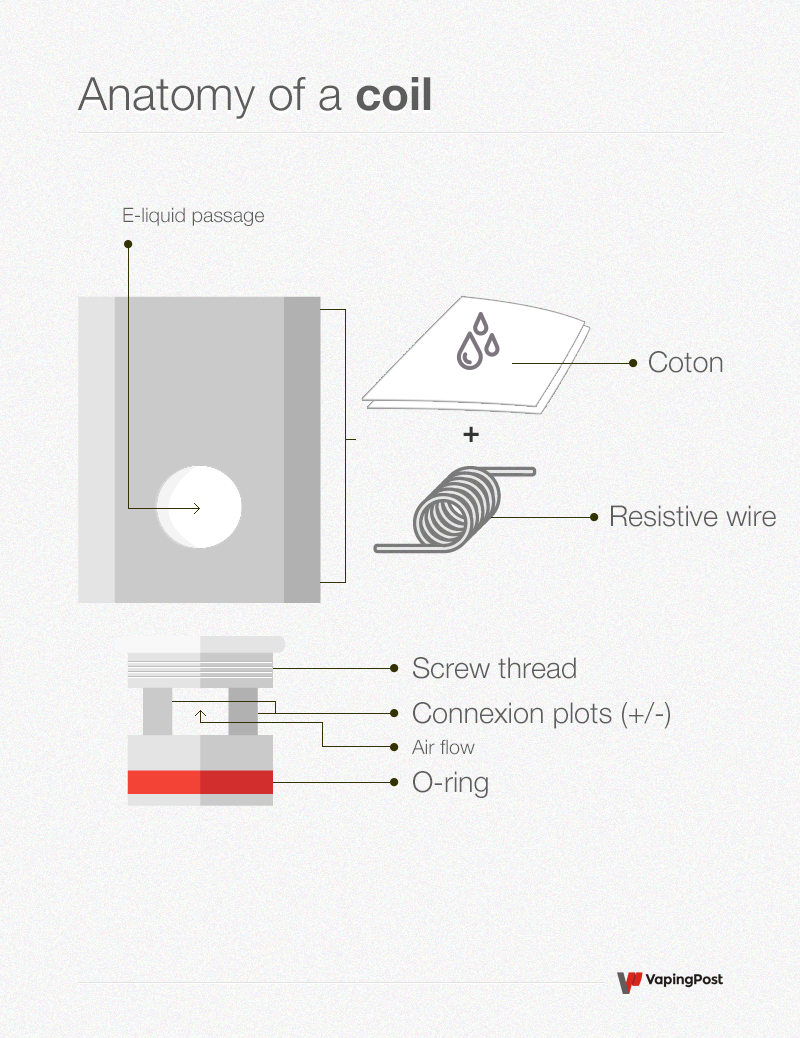The part that heats the e-liquid
The technical principle behind vaporisation has hardly changed since the e-cigarette was first industrialised by Hon Lik. Housed inside a cartridge, the first resistance coils fitted cigalike-type e-cigarette models, and even then used a Kanthal resistance wire surrounded by an absorbent material, usually fibreglass or synthetic foam. Today, although the materials have changed, the principle remains the same. A short history of resistance wicks might read as follows:
- 2009: Nylon 6 wadding, carded cotton wool, fibreglass
- 2011: Silicon fibre, mesh
- 2012: Fonty cotton, organic cotton
- 2014: Cotton Bacon, Fiber Freaks*
Nowadays, there also are different types of metal for making coils. As well as the traditional Kanthal, you can now buy coils made of nickel-chrome, stainless steel or titanium. These allow mods to control temperature better, or improve conductivity between the battery and the coil.
The resistance values of these metal wires are decreasing all the time. It’s quite common nowadays to use a resistance of less than 1 ohm, a figure which has halved since 2009, giving rise to the name “sub-ohm” (below 1 ohm) for this type of coil.
This trend is explained by a “race for the cloud” which has driven the market to produce increasingly high-performance atomizers. In fact, the lower the resistance the faster it heats and the hotter it gets. That vaporises more e-liquid and creates denser vapour. But it takes a lot more e-liquid to work that fast and at higher temperatures, so the coil needs to be wrapped in an effective absorbent material and must be kept moist. A direct result of low-resistance, high-power atomizers is that the vapour contains higher levels of nicotine. That has led the e-liquid market to adapt to more popular, relatively low nicotine levels (0, 3 or 6 mg/ml).
The absorbent materials used to hold the e-liquid in resistance coils have also changed. The synthetic foam used in the first cartomizers was dropped in favour of the plant fibre (cotton-based) now used in most resistance coils. Its excellent wicking properties mean cotton can deliver a lot more e-liquid to the atomizer. Ceramic systems are now gaining ground as an alternative to cotton.
How a coil works

Using a coil
As they come into direct contact with the e-liquid and are subject to huge temperature variations, resistance coils in e-cigarettes have a limited lifespan. It’s important to use the right resistance coil for your equipment (your box mod for example). Apart from the obvious need to be compatible (atomizer manufacturers generally only make resistance coils that work with their own products), it is essential that you set the wattage of your e-cigarette to the most suitable setting for the resistance coil you’re using (check the user guide for your device). The table below shows vaping power depending on the resistance and voltage produced by the mod. The good thing about electronic mods is that they regulate the wattage themselves and do these calculations for you.
Power based on voltage (V) and resistance (Ω)
The table below shows vaping power depending on the resistance and voltage produced by the mod. The good thing about electronic mods is that they regulate the wattage themselves and do these calculations for you.
Power based on voltage (V) and resistance (Ω)
| 0,5 Ω | 0,8 Ω | 1,0 Ω | 1,2 Ω | 1,5 Ω | 1,8 Ω | |
|---|---|---|---|---|---|---|
| 3,3 V | 21,8 W | 13,6 W | 10,9 W | 9,1 W | 7,2 W | 6 W |
| 3,5 V | 24,5 W | 15,3 W | 12,3 W | 10,2 W | 8,2 W | 6,8 W |
| 3,7 V | 27,4 W | 17,1 W | 13,7 W | 11,4 W | 9,1 W | 7,6 W |
| 4,0 V | 32 W | 20 W | 16 W | 13,3 W | 10,6 W | 8,8 W |
| 4,3 V | 37 W | 23,1 W | 18,5 W | 15,4 W | 12,3 W | 10 W |
| 4,5 V | 40,5 W | 25,3 W | 20,2 W | 16,9 W | 13,5 W | 11,2 W |
| 4,8 V | 46 W | 28,8 W | 23 W | 19,2 W | 15,4 W | 12,8 W |
| 5,0 V | 50 W | 31,2 W | 25 W | 20,8 W | 16,7 W | 13,9 W |
N.B.: The hotter your resistance coil gets (high voltage), the more the e-liquid can degrade. Although e-cigarette vapour is less harmful for smokers than smoking tobacco, it is important to remember that vapour can contain compounds that may be harmful to health (particularly aldehydes). This applies even more when an e-liquid is heated a lot and the resistance coil doesn’t get enough e-liquid. That’s why we advise not overheating your resistance coil, spacing out your puffs and always making sure your resistance coil is always well-soaked in e-liquid.
When should you change your coil?
The easiest way to know when to change your resistance coil is to pay attention to how it feels when you vape. If your regular e-liquid is losing its flavour, the vapour is generally starting to taste burnt, or it feels drier than usual, it’s probably time to change your resistance coil. You can also look at the resistance coil to check that it’s not too clogged up. A phenomenon known as the Maillard reaction means that heating e-liquid degrades it, leaving dark-coloured deposits on the surface of the resistance coil. Unfortunately, depending on the type of resistance coil you use, it might be impossible to look and check because you can’t actually see it or the cotton. In that case, you’ll have to rely on your taste buds to know when the resistance coil is worn out. If you vape every day, changing the resistance coil every two weeks, or more often, seems to us to be a fairly consistent average.
